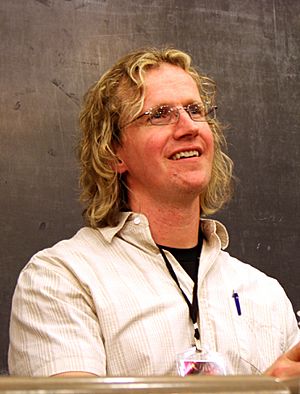R. Scott Bakker facts for kids
Richard Scott Bakker was born on February 2, 1967. He is a Canadian author known for writing fantasy novels. He grew up on a tobacco farm in the Simcoe area of Ontario, Canada.
Quick facts for kids
R. Scott Bakker
|
|
|---|---|

Bakker at SFeraKon 2009
|
|
| Born | February 2, 1967 Simcoe, Ontario, Canada |
| Occupation | Philosopher/Novelist |
| Genre | Science Fiction/Fantasy |
Contents
His Books
Fantasy Stories
The Second Apocalypse Series
The Second Apocalypse is a big fantasy series. It has three main parts. These parts are called The Prince of Nothing, The Aspect-Emperor, and The No-God.
When Bakker started writing this series, he planned it as three books. But he had so many ideas for characters and stories. So, he decided to make each book into its own sub-series.
The Prince of Nothing books came out between 2004 and 2006. The Aspect-Emperor series was published from 2009 to 2017. The last part, The No-God, has not been published yet.
Other Novels
Neuropath
While working on his fantasy series, Bakker wrote a science fiction thriller. This book is called Neuropath. It was published in 2008.
..... This killer knows a lot about the human brain. They use their knowledge to control people's minds.
The Disciple of the Dog
Bakker released another novel in November 2010. It was published before the second Aspect-Emperor book. This book is called Disciple of the Dog.
It features a private investigator named Disciple Manning. He has a special memory condition. The story is about him solving a case. It involves a missing girl, a cult, and small-town secrets. Bakker had plans for more books about Disciple Manning. However, these sequels were not made. This was because the first book did not get many reviews.
Other Planned Works
Bakker also has other books he has been working on. One is called Light, Time, and Gravity. He also plans an anthology of short stories. This collection is named Atrocity Tales. These stories are set in his Second Apocalypse fantasy world.
He also mentioned two science fiction novellas. These are called Semantica and The Lollipop Factory. Semantica is rumored to be about a world with brain enhancements. These enhancements create different social classes.
His Ideas and Philosophy
Bakker is also a philosopher. He has explored ideas about how our brains work. He often writes about these ideas in his books.
Blind Brain Hypothesis
In his book Neuropath, Bakker included an essay. In this essay, he talked about his "Blind Brain Hypothesis." This idea suggests that our conscious mind only sees a small part of what our brain does.
He uses examples like our field of vision. We can only see so much at once. He argues that our sense of "now" or the present moment might be similar. It could be a small part of all the brain's processing.
Bakker believes that as science grows, we will learn more about the brain. This could lead to new ways of understanding human behavior.
The Semantic Apocalypse
In 2008, Bakker gave a talk called The End of the World As We Know It: Neuroscience and the Semantic Apocalypse. He talked about how science often replaces old explanations. He thinks this will happen with our understanding of the brain too.
He used the "Blind Brain Hypothesis" as a metaphor. He compared it to a magician's coin trick. The brain is tricked because it tries to find a clear cause for everything. But our conscious mind only gets limited information.
He also discussed how much money is spent on using brain science for marketing.
The Last Magic Show
In 2012, Bakker shared a paper called The Last Magic Show: A Blind Brain Theory for the Appearance of Consciousness. This paper further developed his "Blind Brain Theory."
He explained that this theory describes how consciousness appears to us. It does not explain the exact brain systems behind it. He suggests that our conscious experience is limited. It is like how we cannot see beyond the edge of our vision.
He uses examples like change blindness. This is when we do not notice big changes in a scene. This shows that our brain processes more than we are consciously aware of.
Bakker also talks about flicker fusion. This is when a light flashes so fast that we see it as steady. This is another example of how our perception is limited.
See also
 In Spanish: R. Scott Bakker para niños
In Spanish: R. Scott Bakker para niños

